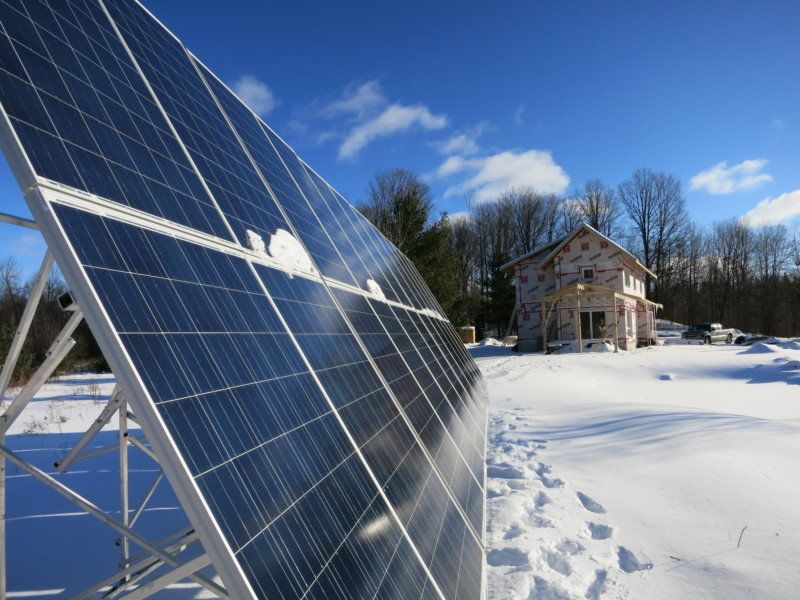Many of our customers have cottages, some are used throughout the winter, some are left to their own devices. Both cases present a challenge when there is an off-grid electrical system: Panels get covered in snow, and therefore don’t contribute to charging the batteries. At the same time, the Achilles heel of lead-acid batteries is that they do not like sitting at partial charge for long periods of time. What can we do about this?
It is surprising how little snow cover it takes to bring solar panel output to a grinding halt. Just a dusting of snow and there’s zero output! One solution is to put solar panels up at a steep angle, making it more likely for snow to slide off, and we have been selling (and in the past also installing) FabRack racking units that allow for the tilt-angle to be changed to 60 degrees in winter. At that angle snow does indeed slide off pretty well. It is the times where there is just a bit of snowfall, enough to blanked the panels, but not enough to get to the weight needed to slide down, that manual clearing is still needed.
A solution I have been seeing used by some cottage owners is to put some (or all) panels up at a full 90-degree tilt-angle. Vertical in other words! That solution does indeed work very well: Snow is much less likely to settle on the panels to begin with. In case you wonder, even at this angle there are times when snow clings to the panels (and for some reason in particular to the bottom, which is an argument to mount panels in landscape rather than portrait, so they still produce 2/3 of what they would do when clean, whereas in portrait the output would be zero when the bottom is covered). It is rare though, and panels will be snow-free for most of the time through winter.
What comes to mind is how the tilt-angle affects energy yield. In particular at other times of the year. I thought it would be helpful to put some numbers to this. One thing to keep in mind is that the steeper the tilt-angle of the panels, the more it matters that they actually face true south. So, for south-facing panels with no other sources of shading, what is the effect of tilt-angle on energy yield throughout the year? Here are some numbers for our location (at 45 degrees latitude):
| Tilt-Angle | December | March | July |
|---|---|---|---|
| 30 degrees | 38% | 85% | 100% |
| 40 degrees | 42% | 87% | 95% |
| 60 degrees | 46% | 87% | 80% |
| 90 degrees | 45% | 70% | 47% |
What does this show?
All the numbers are relative to each other; I simply declared the highest energy yield to “100%” and related all the other numbers to it. The table shows that 30-degree tilt-angle in July produces the most energy, so that is 100%. By the way, for us the best year-around tilt-angle for energy yield is right around 40 degrees. Of course, that is when the snow is kept off the panels in winter, and this is not the best angle for winter yield when off-grid use is most desperate.
What the table shows is that at 60 degrees the panels do very well in winter (if they are kept clean)! You might even be tempted to just leave them at that angle, in summer you still get 80% of the best yield, and usually summer has energy coming out your off-grid ears anyway.
So how does 90 degrees tilt-angle fare? Mid-winter energy yield is very good, right around the maximum that can be made. Snow won’t be a problem at that angle, so that is not a bad way to mount panels! Pretty decent early-spring (and fall) yield too, but summer is not so good, bringing in just about the same energy as in winter. It could be that’s enough for your needs, though usually things are pretty tight in winter and off-grid life gets better when more energy comes in from spring through fall.
One possibility could be to mount some panels vertically, with their own charge controller, to improve winter energy yield. In particular for a cottage that is not used in winter this can work to keep the batteries charged; even a single panel with a little charge controller would go a long way.
Hopefully this article helped put some numbers to the problem and provide food for thought. A very good source of solar yield information is the US government Web site PV-Watts. It uses actual weather data and works for any location on earth. It provides monthly insolation values based on location, panel azimuth, and tilt-angle. Those insolation numbers are representative of energy yield, making it easy to compare various scenarios.
If you have any questions, or need an off-grid system designed for your particular case, feel free to contact us!
-Rob-





Good article Rob, It is also worth mentioning that snow will some times stick to the panels due to a small layer of ice holding the snow in place. If you clean a small section of the panel, the sun will heat up the panel and it will shed the snow. I have a video that I will try to post to this site that shows steam coming off my panels and its -27C.
Very nice post. I just stumbled upon your blog and wanted to say that I’ve really enjoyed browsing your blog posts. In any case I’ll be subscribing to your feed and I hope you write again soon!
Interesting to see your numbers.
Can we assume that a tilt angle half way between 60 and 90 degrees would yield a percentage halfway between 80% and 47%? or is there a curve?
The other thing that occurs to me is, how long the face of the panels are exposed to the sun at the various angles i.e. if the panels are set to 0 degrees (flat) they will receive sun from sunrise to sunset.
That exposure time will be reduced as the angle is increased. Do you have any numbers that might assist with calculating the compromise that exists between the improved exposure that comes with optimizing the angle and the loss of exposure time with the higher angles?
Chris, it’s not linear. The curve is roughly sinusoidal. What angle gives the most energy yield depends if this is annual, or for a certain time of year. Annual yield for most places is maximized by placing panels at a tilt-angle of about the latitude (for us in Ottawa that is 45 degrees north, so a tilt of around 45 degrees results in the most energy). You can play with the numbers; tilt-angle, or azimuth, versus yield for almost anywhere on earth with the PV-Watts calculator: https://pvwatts.nrel.gov/pvwatts.php
The same can also be used for off-grid systems though it is not intended as such. The output shows values for monthly ‘insolation’, in essence what a kW of solar PV would yield in kWh per average day for that month, without taking losses into account.
Great info and explanation, Rob. Extremely helpful and informative!
Indeed, I will be mounting vertical panels (horizontally) on my cottage shed (south facing) in Killarney Provincial Park given that my roof panels are mostly inaccessible and routinely covered in snow.
Just one question — why should they have their own charge controller? I currently have an Outback Flexmax 60 servicing my roof panels.
Many thanks,
Len
Rob, this is great information and very clear explanation. Extremely helpful – thank you!
Indeed, at my cottage in Killarney Provincial Park, I will now be adding separate vertical panels (on the horizontal) on my shed (south facing).
Just one question – why should they have their own charge controller? I have an Outback Flexmax 60 currently servicing my roof panels.
Thanks,
len
Hi Len: I believe the answer is that the vertical and tilted panels will have different operating points since they have different insolation due to their different tilt antlers. The MPPT algorithm in a solar charge controllers will attempt to optimize for this combined panel operating curve, which will not be optimum for either one of the panels. in other words, you’ll get more power from your panels with separate charge controllers.
Andy, Ottawa
Andy & Len, in theory, yes, the Maximum Power Point is different for vertical vs. otherwise tilted panels. However, in practice the difference is negligible. The Voltage produced by a panel is nearly independent of the amount of light hitting it, this holds over quite a range of lighting conditions. The MPP likewise happens at very nearly the same Voltage, it’s actually more a function of temperature than light. It is the current that changes nearly linearly with the amount of light hitting a panel. Twice the light, twice the current. Yes the MPP moves a little, but power output would have been very nearly the same if it was forced to follow some other panel’s MPP (with a different amount of light hitting it).
-Rob-
Thanks Rob for your well written, informative, logical, easily understood articles.
I don’t get why landscape is better than portrait.
A taller/portrait panel will have more available surface above the snow level than a wider/landscape panel.
As the snow level inches upward on a hypothetical 24″ X 36″ panel…
it will lose 24 sq inches of exposed surface area for every additional inch of snow – if its in portrait (24″W x 36″H).
whereas
it will lose 36 sq inches of exposed surface area for every additional inch of snow – if its in landscape (36″W x 24″H)
Marshall, it has to do with how panels work internally: They are divided in 3 parts. When you shade even a single cell in any of those 3 parts, you loose 1/3 of the panel (that part gets bypassed using the “bypass diodes” mounted in the junction box of the panel). If you have a panel in portrait, the 3 sections consist of the left 2 columns, middle 2 columns, and right 2 columns of cells. So, in case there is snow across the bottom of the panel (in portrait) you loose the entire panel. The output will be zero. In case of landscape you would have lost just 1/3, and still get to use 2/3 of the panel for production.